Catchers: Tips, Drills, Information, Catching Equipment, Catchers Gear |
 |
 |
  Cup and Jock Strap - ALWAYS wear a cup when catching. A fouled
pitch could potentially cause serious injury if you are not protected.
These can be found at any sporting goods store and are usually sold
together. Price Range: $5 - $30
Cup and Jock Strap - ALWAYS wear a cup when catching. A fouled
pitch could potentially cause serious injury if you are not protected.
These can be found at any sporting goods store and are usually sold
together. Price Range: $5 - $30
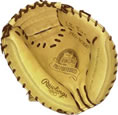  Catcher's Mitt - The best catcher's mitt is not always the most
expensive mitt. Find a mitt that fits your hand and feels comfortable.
It will take awhile to break-in a new mitt. DO NOT use a brand new mitt
in a game. You will have a difficult time catching pitches and ball
will constantly pop out. Break in your new mitt during practice and
when catching bullpen sessions. Catchers in older age groups should
consider having a back-up mitt incase your laces break on your game
mitt. *See our section for information on how to break in your mitt.
Price Range: $30 - $380
Catcher's Mitt - The best catcher's mitt is not always the most
expensive mitt. Find a mitt that fits your hand and feels comfortable.
It will take awhile to break-in a new mitt. DO NOT use a brand new mitt
in a game. You will have a difficult time catching pitches and ball
will constantly pop out. Break in your new mitt during practice and
when catching bullpen sessions. Catchers in older age groups should
consider having a back-up mitt incase your laces break on your game
mitt. *See our section for information on how to break in your mitt.
Price Range: $30 - $380
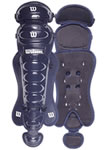  Shin Guards - Shin guards should protect the front of the leg,
knee, and top of the foot. When wearing your shin guards, the straps
should not be too loose or too tight. Do not buy shin guards that are
too large for your body, expecting to grow into them. This will only
inhibit your movement and make your job a lot more difficult behind
the plate. Price Range: $25 - $125
Shin Guards - Shin guards should protect the front of the leg,
knee, and top of the foot. When wearing your shin guards, the straps
should not be too loose or too tight. Do not buy shin guards that are
too large for your body, expecting to grow into them. This will only
inhibit your movement and make your job a lot more difficult behind
the plate. Price Range: $25 - $125
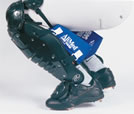  Knee Savers - Knee Savers are simply triangular pads that are
connected to the straps on the back of your shin guards and makes squatting
more comfortable and easier on your knees. You DO NOT need Knee Savers.
They are NOT a mandatory item. I have included them in the list because
more and more catchers are using them. You even see Knee Savers being
used by some catchers at the major league level. Some people like them,
some don't. I think Knee Savers are bad for two reasons: they restrict
your movement and they make you lazy behind the plate. Price Range:
$15 - $20
Knee Savers - Knee Savers are simply triangular pads that are
connected to the straps on the back of your shin guards and makes squatting
more comfortable and easier on your knees. You DO NOT need Knee Savers.
They are NOT a mandatory item. I have included them in the list because
more and more catchers are using them. You even see Knee Savers being
used by some catchers at the major league level. Some people like them,
some don't. I think Knee Savers are bad for two reasons: they restrict
your movement and they make you lazy behind the plate. Price Range:
$15 - $20
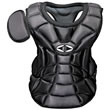  Chest Protector - The chest protector should fit snugly against
your body. There should be no space between any part of your body and
the chest protector (this includes while in the squatting position).
If a ball gets caught in your gear, the ball is considered dead and
out of play. Any base runners will advance one base. Again, do not purchase
a chest protector that is too large. It will only impede your movement.
Some protectors have shoulder guards for extra protection. These are
fine if they are removable. You may want to remove the guard on your
throwing shoulder so it does not impede your ability to throw. Price
Range: $15 - $100
Chest Protector - The chest protector should fit snugly against
your body. There should be no space between any part of your body and
the chest protector (this includes while in the squatting position).
If a ball gets caught in your gear, the ball is considered dead and
out of play. Any base runners will advance one base. Again, do not purchase
a chest protector that is too large. It will only impede your movement.
Some protectors have shoulder guards for extra protection. These are
fine if they are removable. You may want to remove the guard on your
throwing shoulder so it does not impede your ability to throw. Price
Range: $15 - $100
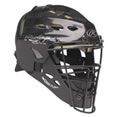  Mask and Helmet/Goalie Mask - Most leagues have now made it mandatory
for catchers to use a hockey style goalie helmet. These helmets, while
safer, are also more expensive than the old two-piece mask and catcher's
helmet. Again, the mask should not be too large. Make sure you purchase
the mask from the baseball section and NOT the hockey section of a sporting
goods store. If you are still using a two-piece mask and helmet, make
sure the helmet fits and then adjust the straps on the mask so it's
snug to your head and helmet. A loose mask is bad. Also, for both types
of head protection, make sure there is some sort of throat protection.
Most modern masks are made with an extended throat guard. Ask if you
are unsure. Price Range: Hockey Style $50 - $150
Mask and Helmet/Goalie Mask - Most leagues have now made it mandatory
for catchers to use a hockey style goalie helmet. These helmets, while
safer, are also more expensive than the old two-piece mask and catcher's
helmet. Again, the mask should not be too large. Make sure you purchase
the mask from the baseball section and NOT the hockey section of a sporting
goods store. If you are still using a two-piece mask and helmet, make
sure the helmet fits and then adjust the straps on the mask so it's
snug to your head and helmet. A loose mask is bad. Also, for both types
of head protection, make sure there is some sort of throat protection.
Most modern masks are made with an extended throat guard. Ask if you
are unsure. Price Range: Hockey Style $50 - $150
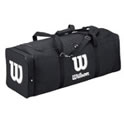  Catcher's Equipment Bag - You will need a way to carry all of
your gear. Depending on the amount of money you want to spend, you have
a few options. Most companies that make catcher's equipment also make
catcher's bags. The bags are specialized and usually have one large
area for the main equipment and various smaller pockets for storing
odds and ends. Some bags even have a section for bat storage. Your other
less expensive option is to purchase a large sturdy duffel bag to carry
your equipment. If catching is new to you, a large duffel bag will work
fine. Price Range: $25 - $100
Catcher's Equipment Bag - You will need a way to carry all of
your gear. Depending on the amount of money you want to spend, you have
a few options. Most companies that make catcher's equipment also make
catcher's bags. The bags are specialized and usually have one large
area for the main equipment and various smaller pockets for storing
odds and ends. Some bags even have a section for bat storage. Your other
less expensive option is to purchase a large sturdy duffel bag to carry
your equipment. If catching is new to you, a large duffel bag will work
fine. Price Range: $25 - $100

Note: Catcher's gear is designed to protect areas of the body
that are most susceptible to being hit or injured by foul tips and balls
in the dirt. Balls will sometimes hit you where you are not protected
with gear. This is part of playing the position. Unprotected areas where
you will likely be hit include your arms and inside or underneath the
thighs. The best thing you can do if this happens is ice the area after
the game. |
 |
 Catching 101
Catching 101
OnBaseball.com

|







